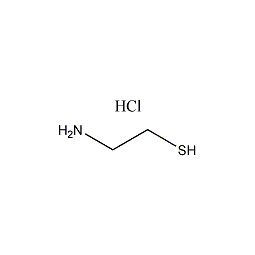
Structural formula
| Business number | 03ZR |
|---|---|
| Molecular formula | C2H8ClNS |
| Molecular weight | 113.61 |
| label |
Cysteamine hydrochloride, 2-Aminoethane-1-thiol hydrochloride, Mercaptamine hydrochloride, 2-Mercaptoethylamine hydrochloride, Mercaptoethylammonium chloride, Cysteine Hydrochloride, β-Mercaptoethylamine hydrochloride, C2H7NS·HCl, chain transfer agent |
Numbering system
CAS number:156-57-0
MDL number:MFCD00012904
EINECS number:205-858-1
RTECS number:KJ0200000
BRN number:3590083
PubChem number: 9082
Physical property data
1. Characteristics: white or colorless crystals with a special odor.
2. Density (g/mL,25/4℃): 0.75
3. Melting point (ºC): 66~70
4. Solubility: Easily soluble in water and ethanol.
Toxicological data
1. Acute toxicity: LD50 (rat, abdominal cavity): 2400mg/ kg;
LD50 (mouse, oral): 1352mg/kg;
Ecological data
None yet
Molecular structure data
None yet
Compute chemical data
1. Reference value for hydrophobic parameter calculation (XlogP): None
2. Number of hydrogen bond donors: 3
3. Number of hydrogen bond acceptors: 2
4. Number of rotatable chemical bonds: 1
5. Number of tautomers: none
6. Topological molecule polar surface area 27
7. Number of heavy atoms: 5
8. Surface charge: 0
9. Complexity: 10
10. Number of isotope atoms: 0
11. Determine the number of atomic stereocenters: 0
12. Uncertain number of atomic stereocenters: 0
13. Determine the number of chemical bond stereocenters: 0
14. Number of uncertain chemical bond stereocenters: 0
15. Number of covalent bond units: 2
Properties and stability
None yet
Storage method
Store in a dry, cool and ventilated place to prevent exposure to sunlight and moisture. Contact with metal ions is strictly prohibited.
Synthesis method
None yet
Purpose
1. Used for biochemical research. Treatment and prevention of radiation sickness.
2. Volumetric analysis titration of cobalt, nickel, copper, zinc, cadmium and mercury. Masking agent.
3. It has a variety of physiological effects, such as prolactin inhibitors, which can induce duodenal ulcers in rats.
4. The intermediates of ranitidine and cimetidine can also be used as an antidote for paracetamol poisoning.
5. Chain transfer agent in organic polymer synthesis.
�; mso-ascii-font-family: Arial; mso-hansi-font-family: Arial; mso-bidi-font-family: Arial”>4. Intermediates of ranitidine and cimetidine, also available As an antidote for paracetamol poisoning.
5. Chain transfer agent in organic polymer synthesis.

 微信扫一扫打赏
微信扫一扫打赏

